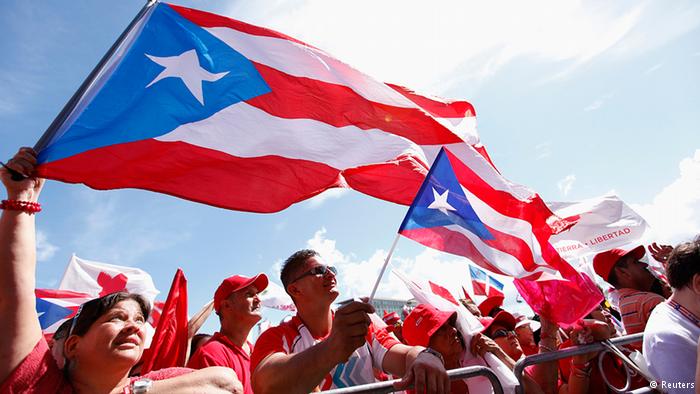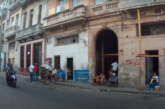
By R. Colon
The unemployment rate of 14.6% exceeded that of any U.S. state. Public worker pensions were strangling the budget.
Puerto Rico an island of just 3.7 million residents owes a staggering $70 billion in debt and had run up a $2.2 billion budget deficit that led credit rating agencies to downgrade Puerto Rico bonds to near-junk status.
Puerto Rico, which became a territory of the United States in 1898 after a war with Spain, cannot legally file for bankruptcy. The island’s constitution states Puerto Rico must make its debt payments before it pays for anything else.
Its only remaining options to pay its debt are to cut spending and raise taxes. Another option is to ask Congress for a bailout. Is a bailout on the table? The answer is no. Have the US offer? The answer is no!
Puerto Rico needs help from congress, but because we don’t have the power to move congress to help the island. You see Puerto Rico does not have a voting member in congress .So I don’t see any real efforts coming from congress.
What Puerto Rico has is a resident commissioner who works with congress and kind of plays the role as a congressman but he can’t vote on bills and with only being one person lobbying and representing the island of Puerto Rico it’s unfair to the almost four million people who live on the island. There are four million people that live on the island that is more people than 23 other states in the US.
Puerto Ricans should have all the rights as do all American citizens. Puerto Ricans fought for this country in almost all the wars and the United States has used the island as training grounds for the military including bombing the island of vieques.
Big companies have also taken advantage of Puerto Rico getting big tax breaks unlike anywhere the U.S. they are encouraged by duty free access to the U.S. and by tax incentives, U.S. firms have invested heavily in Puerto Rico since the 1950s.
In 1993, President Clinton aimed to cut the Section 936 tax exemption for U.S. companies and introduced legislation to Congress to replace it with a more modest tax credit linked to wages paid by those companies in Puerto Rico rather than to profits. It is estimated that 100,000 Puerto Ricans were employed by companies operating under Section 936 (of which 23,000 are in pharmaceuticals) and another 200,000 are indirectly employed. In President Clinton’s 1998 budget submission to Congress, proposed that existing Section 30A of the tax code be made permanent to provide an estimated U.S. $417mn a year in tax incentives to compensate for the phasing out of Section 936. Section 30A allows companies to claim 60% of wages and capital investment as allowances against tax. This did not help the island’s economy. There are many factors have contributed to the island’s fiscal crisis.
Many economists generally blame Puerto Rico’s inability to develop a strong economy on the fact that Puerto Rico is not in control of what they can do on a global level. That’s because anything they do they must first get approval from the US Congress because they are not a state. Unlike any other state they can work with any country do what they think they need to do to attract foreign investors.
Congress did agree to allow U.S. businesses to expand operations without having to pay taxes on their profits there. Pharmaceutical giants such as Pfizer, Merck, Bristol-Myers Squibb and Eli Lilly built plants here, but when Congress in 2006 ended the tax break, many companies found it too expensive to stay. So many of those jobs went and the people of Puerto Rico had no as to what would happen to them went they ended the tax break.
With people losing jobs and tax revenue falling due to businesses closing, Puerto Rico has been borrowing money by issuing bonds. The island found that Puerto Rican bonds were an especially attractive item to investors. Municipal bonds are generally exempt from state and local taxes for those who buy them in the state or city they live in. That “triple-tax-free” status made the territory’s bonds popular. Puerto Rico issued muni bonds to pay off all sorts of things, from government deficits to debt owed on other bonds. From 2000 to 2012, the government’s public debt nearly tripled from $24 billion to $70 billion, according to the Center for a New Economy in Puerto Rico.
Then the real estate collapse hit Puerto Rico. The drop in home prices and the rise in mortgage failures prompted the Federal Deposit Insurance Corp. to force the closure of three Puerto Rican banks in 2010.
Meanwhile, the lack of financial opportunities is driving the young and educated — the very people Puerto Rico needs to fuel its economy are moving to the US.
Since 2000, the island has seen a net loss of 144,000 residents, mostly to the United States. Javier Colon, a political science professor at the university, says the mainland is an “escape valve” for Puerto Ricans.
Puerto Rico’s reliance on the federal government extends to welfare benefits, too. In 2012, island residents received more than $2 billion in food stamps from the federal government. That goes to 37% of the population, higher than Mississippi’s 22%, which is the most of any U.S. state.
Puerto Rico’s agricultural sector use to be one of its most attractive assets and needs to be expanded. Today it accounts for less than 1% of the economy even though the tropical island is rich with fertile land.
Water rates were hiked 60%; taxes have been raised on gasoline, incomes above ,highway tolls and energy price can be three time higher than that of family in the US. For example the home electric bill in an average home in the US is about $80. Per month for that same home in Puerto Rico it can be as much as $280 per month.
While the taxes keep increasing, electric bill too costly and with cost of driving your car to get around it’s making it too hard for the people of the island.
Some say on the island, they feel the welfare system has created a sense of dependence among Puerto Ricans that makes it difficult for them to spur their own economic revitalization.
Many Puerto Ricans say that the US government is responsible for what they have created. The US government needs to step up with a plan to help Puerto Rico and its people to start up small businesses to create jobs.
It‘s time for the people on the island benefit from what the island for what the island has to offer. Puerto Rico says it’s trying to wean itself from the federal government aid and make its own way to move the island forward.
But until we have the same power as the states do with representation in congress we are always going to be depended US government to do what they want to with the island. We need to be self-reliance if Puerto Rico is to become a serious player in the world economy.
Puerto Rico is trying to tax it way out of debt and revenues rose by $70 million, or 4.4%, and some officials here say they can eliminate the budget deficit by 2016. But in the process is hurting the people in island and the people of this beautiful deserve better. Today we are at a point where people mainly come to vacation but won’t be able to truly enjoy the culture and the beautiful of its people who have contribute so much to this country.
The fact that the economy hasn’t grown in seven years, that’s really the underlying problem. By having to Increase taxes as much as they have, it make it almost impossible to have a good quality of life for those who are trying to stay on what is one of the most beautiful islands in the world. IT IS TIME FOR ALL PUERTO RICANS STAND UP FOR PUERTO RICO. There are over 4 million Puerto Ricans live the United States they have power of the vote. Let’s put pressure on congress to something to help the people on the island!
Comments
Powered by Facebook Comments



